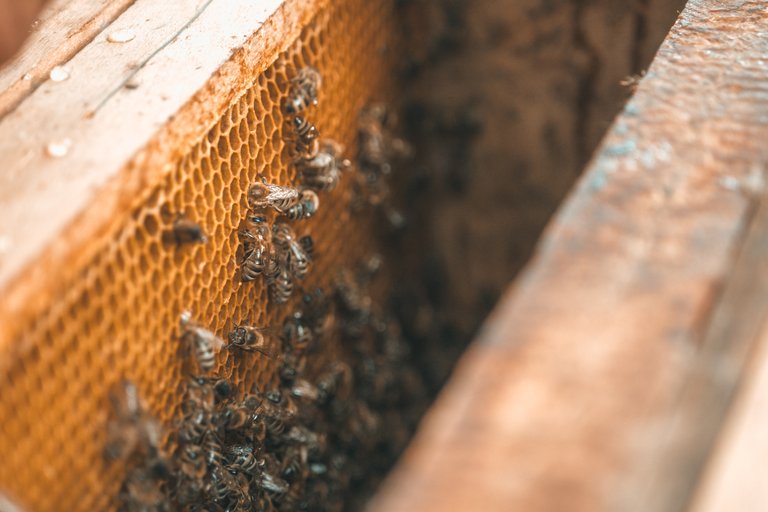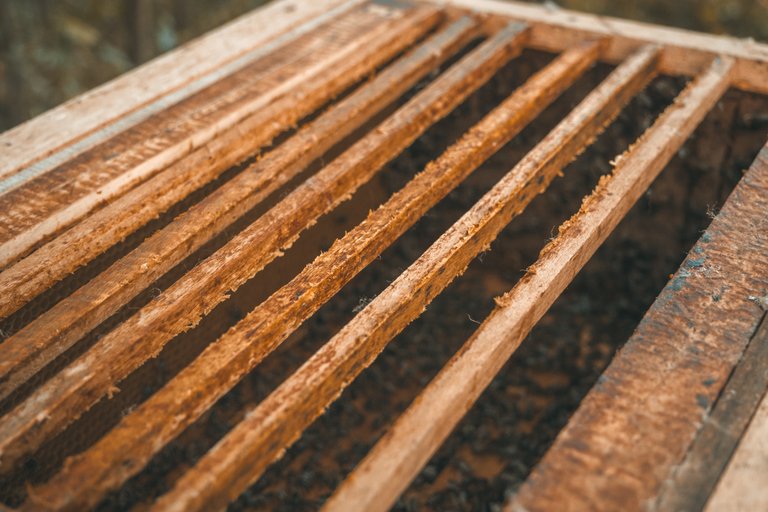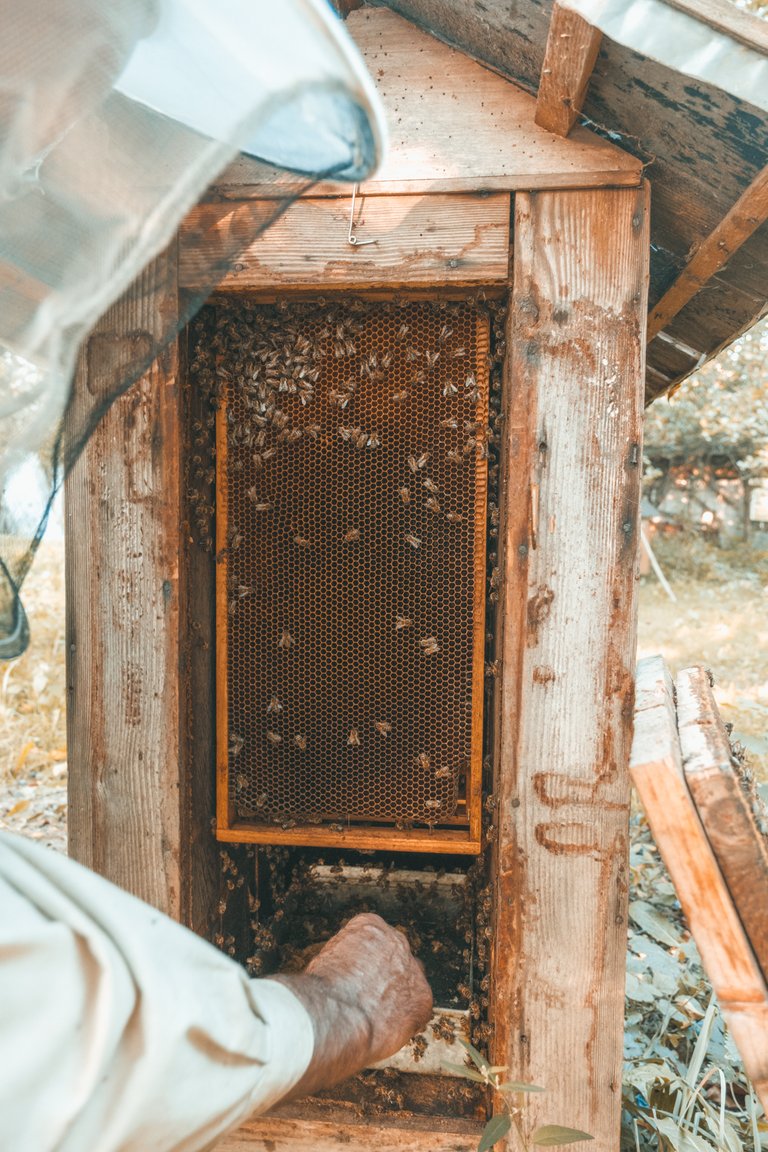Today I am presenting the honey harvest, the last one from this season, 2 months ago. The apiary with bees is very old, everything in it is old and traditional. Everything you will see here is rather rare in modern apiaries.
Please see the photo report, these photos take us back about 30 years 🙂
Dzisiaj prezentuję miodobranie, ostatnie z tego sezonu, sprzed 2 miesięcy. Pasieka z pszczołami jest bardzo stara, wszystko w niej też jest stare i tradycyjne. Wszystko co tutaj zobaczycie jest raczej rzadkością we współczesnych pasiekach.
Zapraszam na fotorelację, tymi zdjęciami przenieśmy się około 20 lat wstecz 😉
Fume maker with wooden decay. The smoke helps calm the bees, they are gentle and allow them to look into the hive.
Dymiarka z drewnianym próchnem. Dym pozwala uspokoić pszczoły, są łagodne, pozwalają zaglądnąć do ula.


The hives were handmade by the owner of the apiary. Some are very old, passed down from father to son. In the photos you can see the basic tools: a broom for sweeping bees from the frames (it is very gentle and delicate), a chisel for prying the frames and removing excess wax, and a fumigation machine (very old, repaired many times).
Ule zostały wykonane własnoręcznie przez właściciela pasieki. Niektóre są bardzo stare, przekazywane z ojca do syna. Na zdjęciach można zaobserwować podstawowe narzędzia: miotełkę do wymiatania pszczół z ramek (jest bardzo łagodna i delikatna), dłuto do podważania ramek i usuwania nadmiaru wosku, oraz dymiarkę (bardzo starą, wielokrotnie naprawianą).








It was the last honey harvest, the photos show many unsealed frames. Then the honey is raw, very liquid, pouring. This type is not suitable for taking away, the bees must first evaporate it and then seal it with wax. The season this year in Poland was quite bad, the owner of the apiary is already preparing the hives for wintering. If any frame is suitable for taking (spun honey), he takes it. The rest stays in the hive.
Było to ostatnie miodobranie, na zdjęciach widać wiele niezasklepionych ramek. Wtedy miód jest surowy, bardzo płynny, lejący. Takie raczej nie nadaje się do zabrania, pszczoły muszą go najpierw odparować, później zalepiają go woskiem (zasklepiają). Sezon w tym roku w polsce był dość kiepski, gospodarz pasieki przygotowuje już ule do zimowania. Jeżeli jakaś ramka nadaje się do wzięcia (odwirowania miodu), zabiera ją. Reszta zostaje w ulu.















You can see many wooden boards in the photos below - these are bars that separate the frames, creating distance so that the bees can move freely between each other. The design of the hive is very old, such solutions are rarely used nowadays due to the time-consuming nature of inspecting the hive, and long working time means higher costs. The host does it traditionally.
Widać na poniższych zdjęciach wiele drewnianych deseczek, są to beleczki, które oddzielają od siebie ramki, tworząc dystans, żeby pszczoły mogły się swobodnie przemieszczać między sobą. Konstrukcja ula jest bardzo stara, współcześnie rzadko stosuje się takie rozwiązania ze względu na czasochłonność przeglądu ula, długi czas pracy to większe koszty. Gospodarz robi to tradycyjnie.




Here a different hive design, the bees can be seen from the top and by opening the side wall. The beekeeper feeds the bees for the winter, gives the wax from uncapping the honey in a metal bowl (in this case the container is empty), the bees will transfer the remaining honey to the frames and prepare for the winter. Later they will receive sugar syrup in such a container to make more winter supplies. If you collect honey from bees, you need to give them sugar before winter so that they can survive.
Tutaj inna konstrukcja ula, do pszczół można zobaczyć od góry, oraz otwierając boczną ściankę. Pszczelarz karmi pszczoły na zimę, w metalowej misce podaje wosk z odsklepiania miodu (w tym przypadku pojemnik jest pusty), pszczoły te pozostałości miodu przeniosą do ramek, będą się przygotowywać na zimę. Później otrzymają do takiego pojemnika jeszcze syrop z cukru, żeby zrobiły więcej zapasu zimowego. Jak się pszczołą odbiera miód to przed zimą trzeba im dać cukier, żeby mogły przetrwać.




Others in this series:
🐝 Hives from Poland #4 Zacisze z ulami wielkopolskimi
Photo by @szejq 📸 | Fuji X + Fujinon XF 16-80mm F4 R OIS WR | Adobe Lightroom

Very interesting seeing the old traditional honey bee farming, thanks for sharing.
Thanks 🙂
Pleasure, have a productive week.
Cool
Thanks🙂
Youre welcome
!HBIT
Success! You mined 1.0 HBIT on Wusang: Isle of Blaq. Sorry, but you didn't find a bonus treasure token today. Try again tomorrow...they're out there! You can see your random number generated in the Discordtools | wallet | discord | community | daily <><
Check for bonus treasure tokens by entering your username at an H-E explorer or take a look at your wallet.
Read about Hivebits (HBIT) or read the story of Wusang: Isle of Blaq. server, #hbit-wusang-log channel. |
It is great to see this period equipment and how well preserved, I was unaware of many aspects of this activity that you mention.
I'm very sorry that the season was bad.
This is an activity that I would love to do, the big drawback is the lack of space in a place far from the city
Thank you very much for sharing all this information and the beautiful photographs.
Have a happy start to the week
Thank you for your thoughts 😉
We appreciate your work and your publication has been hand selected by the geography curation team on behalf of the Amazing Nature Community. Keep up the good work!
Thank you 😉
Congratulations @szejq! You received a personal badge!
Thank you for participating in the Leo challenge.
You can view your badges on your board and compare yourself to others in the Ranking
Check out our last posts: